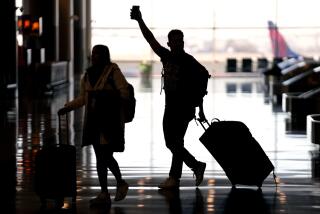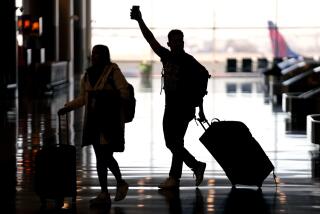Runway Incidents on Decline
WASHINGTON — The number of near-collisions on the nation’s runways dropped sharply last year, an improving safety trend also reflected at Southern California airports, the Federal Aviation Administration reported Wednesday.
As better navigational systems have reduced air collisions in recent years, the risk of runway crashes became the top concern of aviation safety officials. Runway incidents that created a collision hazard were on the rise during the 1990s, and many experts feared that the next big crash would come on the ground.
The FAA statistics showed that such runway incidents fell from 407 in 2001 to 339 in 2002, a decline of 17%. The most serious cases -- incidents in which there was a significant potential or extremely high risk of two jets crashing -- declined even more.
“The trend line is going in the right direction,” said FAA Administrator Marion Blakey. “This is quite good news in terms of airline safety on the ground.”
She credited greater awareness on the part of pilots and controllers, improved ground radar technology and better training. About 60% of all runway incidents are eventually attributed to pilot error, and private pilots are more likely to slip up than are their airline counterparts.
The slump in air travel has also played a part in reducing risks on the runways.
However, the FAA report showed that after accounting for the decline in flights, the rate of runway safety incidents also fell by about 15%.
“There is some relation to volume” of flights, said Bill Davis, head of the FAA’s runway safety program. “But it’s also related to [airport] design. It’s related to a lot of different things.”
At Los Angeles International Airport, where limited space and a high volume of jets make for risky runway conditions, the number of incidents fell from nine in 2001 to six in 2002. At John Wayne Airport in Orange County there was a reduction from 12 safety incidents in 2001 to four in 2002, and at Long Beach there were six incidents in 2001 and five in 2002.
There were no incidents reported at Ontario International Airport for either year, while at Burbank Airport there were no incidents in 2001, but two the following year.
National statistics for the current federal fiscal year show that the improvements appear to be holding. As of the end of June, there had been 240 runway safety incidents compared with 248 for the same period last year. FAA officials acknowledge that they face a stiff challenge maintaining safety gains once the economy recovers and air travel rebounds.
The agency classifies runway safety incidents in four categories, according to their potential for causing accidents.
The most dangerous -- Category A -- is when a collision is narrowly averted by “extreme action,” such as the pilot of an airliner on its takeoff roll scrambling to get airborne to avoid another jet that has inadvertently lumbered onto the runway.
Category B is when a “significant potential for collision” exists. The remaining two categories involve little or no risk of collision. Of the 339 incidents last year, 302 were in these lower-risk categories.
FAA officials said that so far this year there have been no Category A or B incidents in which there was a significant or extremely high risk of collision between two jets. Last year, there were three, down from nine in 2001.
More to Read
Inside the business of entertainment
The Wide Shot brings you news, analysis and insights on everything from streaming wars to production — and what it all means for the future.
You may occasionally receive promotional content from the Los Angeles Times.










